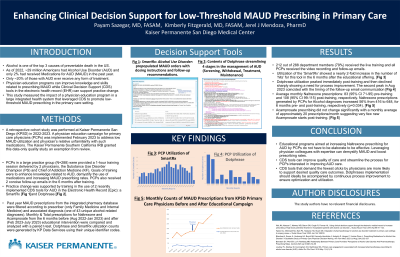Back

(32) Enhancing Clinical Decision Support for Low-Threshold MAUD Prescribing in Primary Care
Friday, April 5, 2024
9:45 AM – 1:15 PM


Payam Sazegar, MD, FASAM
Assistant Professor
Kaiser Permanente Bernard J. Tyson School of Medicine, California
Kimberly Fitzgerald, MD
Chief of Addiction Medicine
Kaiser Permanente San Diego, California
Presenter(s)
Non-presenting author(s)
Background & Introduction: Alcohol has maintained a stronghold as a household staple and remains one of the top three causes of preventable death in the United States. As of 2022, approximately 29 million Americans had Alcohol Use Disorder (AUD) and only 2% had received Medications for AUD (MAUD) in the past year. Furthermore, only an estimated 20% of those with AUD ever receive any form of treatment. Physician education programs can improve knowledge and skills related to prescribing MAUD while Clinical Decision Support (CDS) tools in the electronic health record (EHR) are a potential strategy to support change in prescribing behavior. In this study, we measure the impact of a physician education program in a large integrated health system that leveraged CDS to promote low-threshold MAUD prescribing in the primary care setting.
Methods: A retrospective cohort study was performed at Kaiser Permanente San Diego in 2022-2023. A physician education campaign for primary care physicians (PCPs) was implemented February 2023 to address low MAUD utilization and physician’s relative unfamiliarity with such medications. Primary care physicians (PCPs) in a large practice group (N=288) were provided a brief training session delivered by two physicians, the Substance Use Disorder Champion and Chief of Addiction Medicine, with the goals of: enhancing knowledge related to recently developed CDS tools for AUD, including ‘SmartRx’ and use-friendly ‘dotphrases’ that delineate four steps in the outpatient management of patients with AUD. MAUD orders in ‘SmartRx’ are prepopulated with dosing instructions and contain follow-up recommendations. PCPs received brief follow-up emails twice in the 3 months after training. MAUD prescriptions in the past year were obtained from the integrated pharmacy database and filtered according to prescriber (only family medicine and internal medicine) and associated diagnosis (one of 43 unique alcohol-related diagnoses). Monthly and total prescriptions for Naltrexone and Acamprosate from the 6 months before (Aug 2022-Jan 2023) and after (Feb 2023-July 2023) the educational program were compared and analyzed with a paired t-test using Microsoft Excel Analysis ToolPak.
Results: A total of 212 out of 288 department members (79%) received the live training and all PCPs received the video recording and follow-up emails. The total number of Naltrexone prescriptions generated by PCPs related to alcohol diagnoses totaled 416 and 648 in the 6 months pre-training and post-training, respectively. The average monthly counts of Naltrexone prescription were 83 (95% CI 71-95) pre-training and 108 (95% CI 99-115) post-training, respectively. This represented a 56% increase (p=0.034) in MAUD prescriptions by PCPs attributable to the training and accompanying CDS tools. Utilization of the ‘SmartRx’ tracked by the Information Technology department showed a nearly 2-fold increase in the number of ‘hits’ for this tool in the 6 months after the educational offering. In contrast, rates of Acamprosate did not change significantly with a monthly average of approximately 20 prescriptions/month suggesting very few new Acamprosate starts after the educational program.
Conclusion & Discussion: This study demonstrates that educational programs to increase Naltrexone prescribing by PCPs for AUD do not have to be elaborate to be effective. Leveraging physician colleagues with expertise can demystify MAUD and encourage more MAUD prescribing for either abstinence or harm reduction. Use of CDS tools can improve quality of care and streamline the process for PCPs interested in reducing care disparities for patients with AUD.
References: SAMHSA, Center for Behavioral Health Statistics and Quality. 2022 National Survey on Drug Use and Health. Table 5.22B – Received medication-assisted treatment (MAT) for alcohol use in past year: among people aged 12 and older; received MAT for alcohol use in past year: among people aged 12 and older with past year alcohol use disorder; by demographic characteristics, percentages, 2021 and 2022. https://samhsa.gov/data/sites/default/files/reports/rpt42728/NSDUHDetailedTabs2022/NSDUHDetailedTabs2022/NSDUHDetTabsSect5pe2022.htm?s=5.32&#tab5.22b
Wai JM, Aloezos C, Mowrey WB, Baron SW, Cregin R, Forman HL. Using clinical decision support through the electronic medical record to increase prescribing of high-dose parenteral thiamine in hospitalized patients with alcohol use disorder. J Subst Abuse Treat. 2019 Apr;99:117-123. doi: 10.1016/j.jsat.2019.01.017. Epub 2019 Jan 23. PMID: 30797383; PMCID: PMC6541495.
Hyland CJ, McDowell MJ, Bain PA, Huskamp HA, Busch AB. Integration of pharmacotherapy for alcohol use disorder treatment in primary care settings: A scoping review. J Subst Abuse Treat. 2023 Jan;144:108919. doi: 10.1016/j.jsat.2022.108919. Epub 2022 Oct 28. PMID: 36332528; PMCID: PMC10321472.
Bhardwaj A, Sousa JL, Huskamp HA, Busch AB, Kennedy-Hendricks A, Hodgkin D, Horgan C, Uscher-Pines L. Prescribing Medications for Alcohol Use Disorder: A Qualitative Study of Primary Care Physician Decision Making. Ann Fam Med. 2023 Jul-Aug;21(4):332-337. doi: 10.1370/afm.2997. PMID: 37487716; PMCID: PMC10365869.
Bernstein EY, Pfoh ER, Le P, Rothberg MB. Relationship Between Primary Care Providers' Perceptions of Alcohol Use Disorder And Pharmacotherapy Prescribing Rates. Alcohol Alcohol. 2023 Jan 9;58(1):54-59. doi: 10.1093/alcalc/agac057. PMID: 36368012.
Joudrey PJ, Kladney M, Cunningham CO, Bachhuber MA. Primary care engagement is associated with increased pharmacotherapy prescribing for alcohol use disorder (AUD). Addict Sci Clin Pract. 2019 May 1;14(1):19. doi: 10.1186/s13722-019-0147-3. PMID: 31039820; PMCID: PMC6492411.
Methods: A retrospective cohort study was performed at Kaiser Permanente San Diego in 2022-2023. A physician education campaign for primary care physicians (PCPs) was implemented February 2023 to address low MAUD utilization and physician’s relative unfamiliarity with such medications. Primary care physicians (PCPs) in a large practice group (N=288) were provided a brief training session delivered by two physicians, the Substance Use Disorder Champion and Chief of Addiction Medicine, with the goals of: enhancing knowledge related to recently developed CDS tools for AUD, including ‘SmartRx’ and use-friendly ‘dotphrases’ that delineate four steps in the outpatient management of patients with AUD. MAUD orders in ‘SmartRx’ are prepopulated with dosing instructions and contain follow-up recommendations. PCPs received brief follow-up emails twice in the 3 months after training. MAUD prescriptions in the past year were obtained from the integrated pharmacy database and filtered according to prescriber (only family medicine and internal medicine) and associated diagnosis (one of 43 unique alcohol-related diagnoses). Monthly and total prescriptions for Naltrexone and Acamprosate from the 6 months before (Aug 2022-Jan 2023) and after (Feb 2023-July 2023) the educational program were compared and analyzed with a paired t-test using Microsoft Excel Analysis ToolPak.
Results: A total of 212 out of 288 department members (79%) received the live training and all PCPs received the video recording and follow-up emails. The total number of Naltrexone prescriptions generated by PCPs related to alcohol diagnoses totaled 416 and 648 in the 6 months pre-training and post-training, respectively. The average monthly counts of Naltrexone prescription were 83 (95% CI 71-95) pre-training and 108 (95% CI 99-115) post-training, respectively. This represented a 56% increase (p=0.034) in MAUD prescriptions by PCPs attributable to the training and accompanying CDS tools. Utilization of the ‘SmartRx’ tracked by the Information Technology department showed a nearly 2-fold increase in the number of ‘hits’ for this tool in the 6 months after the educational offering. In contrast, rates of Acamprosate did not change significantly with a monthly average of approximately 20 prescriptions/month suggesting very few new Acamprosate starts after the educational program.
Conclusion & Discussion: This study demonstrates that educational programs to increase Naltrexone prescribing by PCPs for AUD do not have to be elaborate to be effective. Leveraging physician colleagues with expertise can demystify MAUD and encourage more MAUD prescribing for either abstinence or harm reduction. Use of CDS tools can improve quality of care and streamline the process for PCPs interested in reducing care disparities for patients with AUD.
References: SAMHSA, Center for Behavioral Health Statistics and Quality. 2022 National Survey on Drug Use and Health. Table 5.22B – Received medication-assisted treatment (MAT) for alcohol use in past year: among people aged 12 and older; received MAT for alcohol use in past year: among people aged 12 and older with past year alcohol use disorder; by demographic characteristics, percentages, 2021 and 2022. https://samhsa.gov/data/sites/default/files/reports/rpt42728/NSDUHDetailedTabs2022/NSDUHDetailedTabs2022/NSDUHDetTabsSect5pe2022.htm?s=5.32&#tab5.22b
Wai JM, Aloezos C, Mowrey WB, Baron SW, Cregin R, Forman HL. Using clinical decision support through the electronic medical record to increase prescribing of high-dose parenteral thiamine in hospitalized patients with alcohol use disorder. J Subst Abuse Treat. 2019 Apr;99:117-123. doi: 10.1016/j.jsat.2019.01.017. Epub 2019 Jan 23. PMID: 30797383; PMCID: PMC6541495.
Hyland CJ, McDowell MJ, Bain PA, Huskamp HA, Busch AB. Integration of pharmacotherapy for alcohol use disorder treatment in primary care settings: A scoping review. J Subst Abuse Treat. 2023 Jan;144:108919. doi: 10.1016/j.jsat.2022.108919. Epub 2022 Oct 28. PMID: 36332528; PMCID: PMC10321472.
Bhardwaj A, Sousa JL, Huskamp HA, Busch AB, Kennedy-Hendricks A, Hodgkin D, Horgan C, Uscher-Pines L. Prescribing Medications for Alcohol Use Disorder: A Qualitative Study of Primary Care Physician Decision Making. Ann Fam Med. 2023 Jul-Aug;21(4):332-337. doi: 10.1370/afm.2997. PMID: 37487716; PMCID: PMC10365869.
Bernstein EY, Pfoh ER, Le P, Rothberg MB. Relationship Between Primary Care Providers' Perceptions of Alcohol Use Disorder And Pharmacotherapy Prescribing Rates. Alcohol Alcohol. 2023 Jan 9;58(1):54-59. doi: 10.1093/alcalc/agac057. PMID: 36368012.
Joudrey PJ, Kladney M, Cunningham CO, Bachhuber MA. Primary care engagement is associated with increased pharmacotherapy prescribing for alcohol use disorder (AUD). Addict Sci Clin Pract. 2019 May 1;14(1):19. doi: 10.1186/s13722-019-0147-3. PMID: 31039820; PMCID: PMC6492411.
Learning Objectives:
- understand some of the reasons why many patients with AUD do not receive MAUD in the primary care setting.
- develop an organized approach to coaching primary care physicians to increase MAUD prescribing for either AUD treatment or harm reduction.
- acquire skills in the development of clinical decision support tools that impart high yield clinical content relevant to four stages of managing AUD in the outpatient setting.
